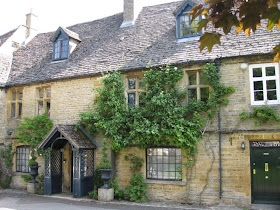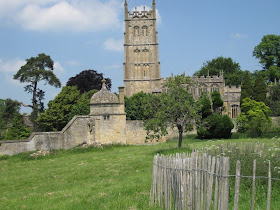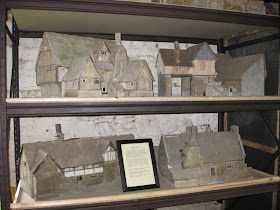
By Claire
June 4
The Cotswolds, a 25 by 90 mile area of Gloucestershire, are a cluster of small, adorable villages; originally the result of a huge wool industry in medieval England where Cotswold sheep grew the best wool. A 12th century saying was “In Europe the best wool is English. In England the best wool is Cotswold.” Wool money built fine towns, houses and cathedrals. Another saying at the time was “I thank my God and ever shall, it is the sheep hath paid for all.”
But, the cotton industry came along, the woolen industry collapsed and the towns fell into a depressed time warp. Today, it is enjoyed by throngs of 21st century tourists who come to see the fairy tale towns. We were among them.
We lucked out with parking, never saw the throngs and saw all the precious sights we were looking for. A thin layer of topsoil covers the Cotswold limestone from which these buildings were made. We saw several quarries as we drove around the region.

We went on a Rick Steves’ walking tour of Stow-on-the-Wold (which means “meeting place on the uplands”) and found the Royalist Hotel, the oldest in England (along with 20 others in England who make this claim). We were surrounded by wonderful old buildings in the town.



This looked like it belonged in Lord of the Rings—maybe it was even an inspiration for J.R.R. Tolkien who was an Oxford Don just down the road and enjoyed hiking in the Cotswolds.

Door on the High Street

Notice how worn these stairs are.

We found the old market, sitting in the middle of town.

The day was absolutely perfect—sunny and warm with just the tiniest breeze. We drove next to Chipping Campden—with our windows rolled down!—which turned out to be my favorite. We used another Rick Steves’ walk, stopping at various used book stores along the way and mostly looking for the homes and gardens.



We found out that they do not use numbered addresses. Instead, each home has a name. I guess people who live here have no problem finding each other. How they do it, I don’t know. The names are not in alphabetical order and without numbers, I would be completely lost.

Chipping Campden neighborhood

Chuck particularly loved this hedge.

Notice the stone dogs and corkscrew bushes that remind me of a soft serve ice cream cone.

More wandering and we came to this church and a secret garden.


Putting off lunch with the idea of having a cream tea somewhere along the way, we pushed on to a National Trust property called Snowshill Manor. Keep in mind that these villages are just 3-8 miles apart through gorgeous countryside with sheep grazing on the hills. We joined the National Trust from home and can visit any of their 350 buildings and gardens in England, Scotland, Northern Ireland and Wales and hope to see as many as we can.
Snowshill Manor

Snowshill Manor is packed to the rafters with a spectacular collection of craftsmanship and design from across the globe. Charles Paget Wade amassed more than 22,000 items during his lifetime including samurai armour, clocks, toys, bicycles, tools and musical instruments. I thought the collection of tiny carvings from animal bones, done by prisoners of war during Napoleonic times were fantastic. The bones were from the prisoners’ food.
While serving as an orderly during WWI in Flanders, Charles Wade came across a 1915 copy of Country Living magazine advertising the house and farm for sale. After the Great War, he went to see the property in 1918 to find out if it was still available. It was, and in a very derelict state; but he bought it and spent 3 years refurbishing it and planting gardens in the grazing fields. He had started collecting things at the age of 7 when each Saturday his grandmother allowed him to play with a Chinese cabinet with numerous drawers filled with curiosities. This was the inspiration for his lifelong dream of acquiring beautifully crafted objects from around the world. Most of the collection was purchased in England and many items were found locally in junk stores, the owners not realizing their worth. He cleaned them up and put them on display. One room hosted a number of sets of samurai armour; five of these were purchased in very dusty condition in England from a hardware store owner who loved them, but whose wife would not permit them in the house.
Surprisingly, the Javanese masks displayed in one room are among a very few items in the collection that were purchased abroad.
The house was one big musty celebration of craftsmanship. The National Trust has cleaned things up and moved things back from the center of the rooms so that people can circulate and see the collection more easily.
Taking seriously his family motto, “Let Nothing Perish,” Wade dedicated his life and fortune to preserving things finely crafted. He wrote of the “thrills of unexpected finds in unexpected places” and the Manor is still presented theatrically according to his wishes. Mr. Wade insisted that light levels be kept low to create a sense of mystery, and that the theatre of the place should not be interrupted by labels. The samurai armour is displayed on life-like mannequins. We suspect these posed figures were created by Wade himself. He was a gifted artist and craftsman and even had a display of his own paintings and model villages (the first of their kind) in the collection. He used the Manor to house the items while living in the much smaller former Priest’s House. Incredibly, he married for the first time at age 63 and his wife lived with him for a time in this small, cramped abode filled with some of his collectibles. We heard one docent comment twice that he could not stay overnight here.
Inside the Priest House



Bathroom with Thunder Box toilet. It also had a huge bathtub.

Models made by Charles Wade

We walked through the extensive grounds and gardens, thoroughly enjoying the day, resting for a while on a bench with a view of the hills.
Bench view

Manor house garden

Manor house pond

One of the nicest things about the day was the fact that they only allow 22 people into the Manor at 10 minute intervals. They gave us a timed ticket and at no time did I feel rushed or crowded. The docents were wonderful and we thoroughly enjoyed talking with them. In fact, I noticed a picture of Henry VIII and asked about it and found out that he used to own the Manor—appropriating this Catholic Church property when he established the Church of England—and gave it to his sixth wife, Katherine Parr. We enjoyed the overlapping stories of our travels: Especially Henry VIII and Katherine Parr from our tour of Hampton Court Palace.
And now it was time for a cream tea. We stopped and asked the young woman in reception (who turned out to be American and from New York and we didn’t even notice!) if she could recommend a good place to have a cream tea in Broadway, the next village on our list. She chatted with us for a few minutes, thrilled to meet Americans (so she said) and directed us to Tisanes. We found it and loved it.

Broadway--small village with wide streets

We were back in the campground by 5pm where we lounged with our Kindles and another Abbot beer. What a great day!
And not a girl goes walking, Along the Cotswold lanes; But knows men's eyes in April, Are quicker than their brains. ~ John Drinkwater
"I say there, dear chap, nothing more lovely than the Cotswolds!" (spoken with an English Accent!) Ha, ha. Been out of town for a week so had some reading to catch up! I do love how tidy and orderly England (mostly)is! Although the Brit expat here on Paros complain bitterly about England, I think it is really and truly beautiful with SO MUCH interesting history! Love all the photos and envy the cream tea! I know you are back in the land of RULES....as compared to the laid back way of NO RULES here in Greece, but hey! Rules work. No Rules seems to get you in trouble! As we are well aware of here in Greekland.
ReplyDeleteCheers!
Karin on Paros
Living here in central Italy, I agree with Karin in Paros: no rules means too much "gray area" where misunderstandings can occur ~ esp if you're not born into the culture, and sometimes miss the unspoken subtext.
ReplyDeleteI think in CA we need fewer rules, because, dude, you know, we're more chill, we all "get it" ... and hey it's all good!